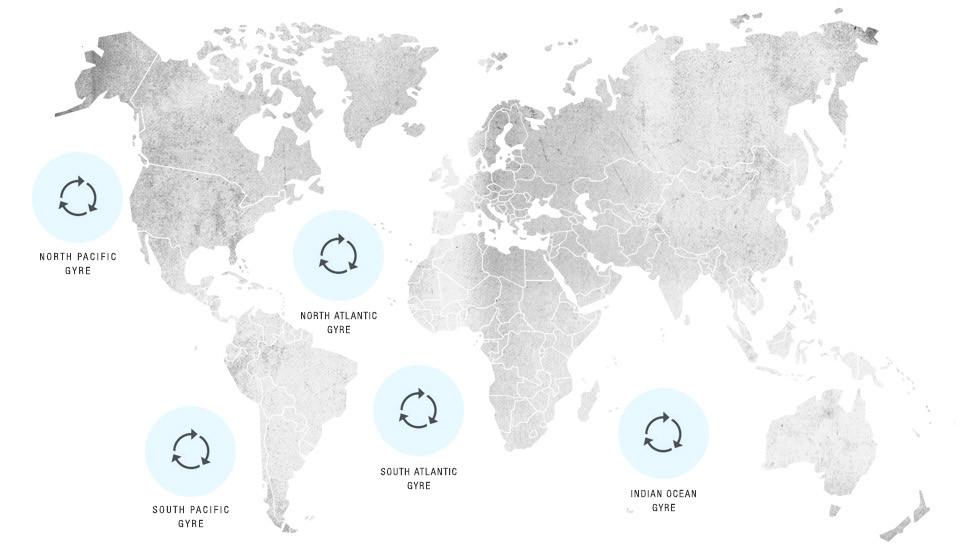We’re the big brained animals on this planet and we’re putting everything in danger because we don’t really understand the planet as a whole, and human beings, through our consumption and our waste, are messing with the system.
FACING OCEAN PLASTIC POLLUTION
A massive amount of plastic trash ends up in our oceans every year. The ocean currents have formed five gigantic slow moving whirlpools where the plastic collects, nicknamed Vortex.
Recent studies indicate that at least 40 million pounds of plastic has accumulated and is floating in the north pacific ocean alone. The majority of the plastic debris remains in the Vortexes, however a significant percentage of it washes onto our coastlines daily.
After sunlight photo-degrades the plastic into small pieces, aquatic life and sea birds mistake these fragments for food and ingest it.
While its difficult to know exact figures, a 2012 report from WSPA indicates that between 57,000 and 135,000 whales are entangled by plastic marine debris every year in addition to the inestimable – but likely millions – of birds, turtles, fish and other species affected by plastic marine debris.
New studies show that ingested plastic damages the internal organs of fish. This raises the question about the safety of our seafood.
If we fail to clean up the plastic and stop the continued pollution of the oceans, we are facing the potential extinction of many sea life species and the interruption of the entire eco-system. We also risk the health of anyone who eats seafood.
MISSION
SCIENTISTS, ENVIRONMENTALISTS, CREATORS AND BRANDS TEAM UP TO SOLVE THE IMPOSSIBLE MISSION.
The big Challenge is to retrieve the floating plastic out of the open sea. The majority of the plastic has broken down into small pieces 1/4” inch or smaller. The plastic trash is scattered over massive areas and is not easily visible or collected. The centre of a Vortex where the plastic concentration is highest is constantly moving. It is difficult to collect the plastic without harming fish and other sea life. Only a minority of the plastic is on the surface, the majority sinks to the ocean floor. But a huge part of the plastic debris is washing up on beaches where it can be collected relatively easily and without complex technology by locally organised clean up organisations.
“I want to be plastic!” Andy Warhol’s phrase expresses the fascination for plastic that we all share. Plastic is perfect. It is sleek, comes in any colour possible and looks stunning when brand new. Also, it comes in all these different types which meet specific usage requirements. That makes it very hard to replace with ecological senseful alternatives. Parallel to the cleaning efforts, The Vortex Project is educating on the responsible use of disposable plastic and funds an r&d think tank to develop alternative materials, filter systems and new recycling systems.
Today, a sexy product can be the most efficient advertising for a cause. It is the best proof of concept for a new technology and gives consumers who care the decision to do the right thing. Therefore the main communication tool of The Vortex Project are beautiful designed products, that are made in a new and more sustainable way and carry the story of ocean plastic pollution into the world. All products made with ocean plastic associated with The Vortex Project contribute to the funding of this initiative.
Creativity is the key to saving creation from our darker side and the key to a future of ecological harmony between humanity and the diversity of wondrous species we share this planet with.
DISRUPT THE CYCLE
THE INITIATIVE
CLEAN UP SHORELINES AND OCEANS, BOOST NEW TECHNOLOGIES AND TURN OCEAN PLASTIC INTO SMART CONSUMER PRODUCTS TO CREATE FUNDING AND AWARENESS.
The Vortex Project is a non-for profit initiative and was founded in 2013 by eco-material innovator Bionic, Sea Shepherd Conservation Society, and Parley – for the Oceans. The project is based on the belief that human economy must be harmonised with the eco system of nature in order to make a serious impact.
Since its founding, a variety of environmentalists, scientists, artists, entrepreneurs, creative companies and non-for-profit organisations have joined the cause. The advisory board includes Plastic Pollution Coalition, Ocean Alliance, Mare, Warner Babcock Institute for Green Chemistry, Alba Group.
 The retrieved plastic is broken down into chipis and then shredded to fibres, ready to be spun into yarn.
The retrieved plastic is broken down into chipis and then shredded to fibres, ready to be spun into yarn.
Ocean plastic fibres are spun into strong core yarn and then helixed with cotton, making Bionic® yarn.























